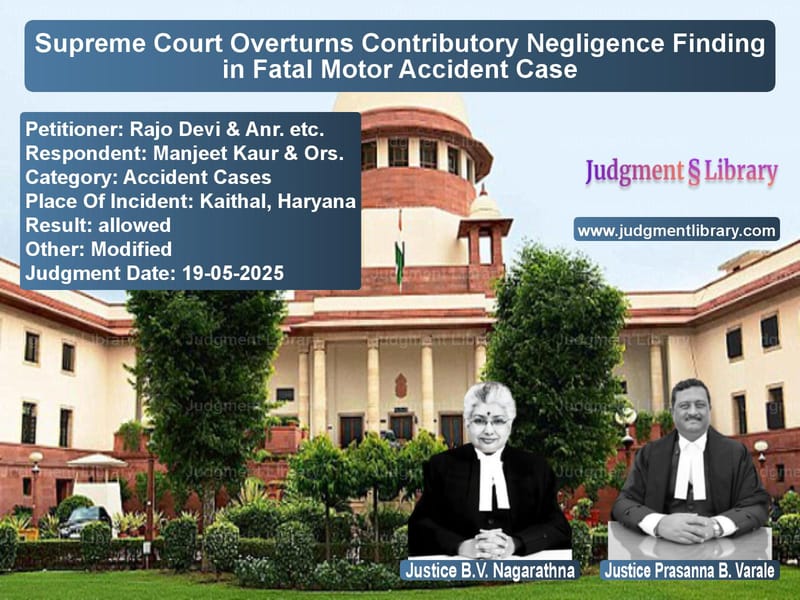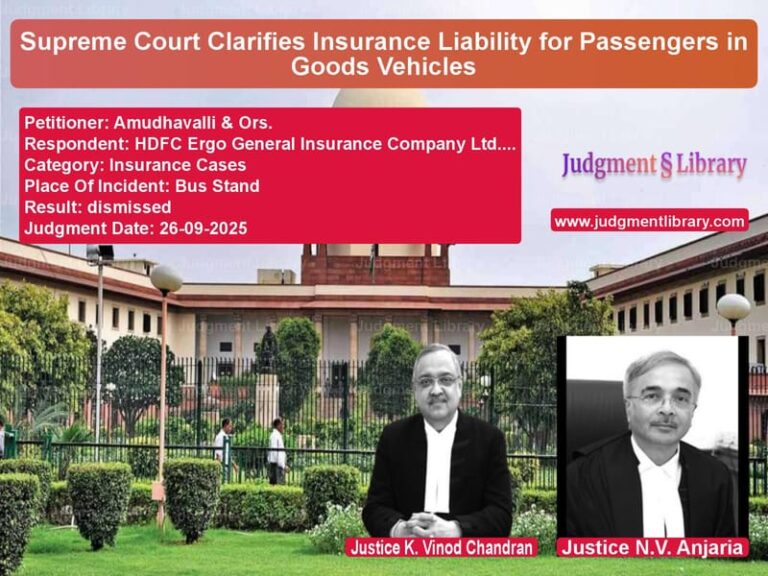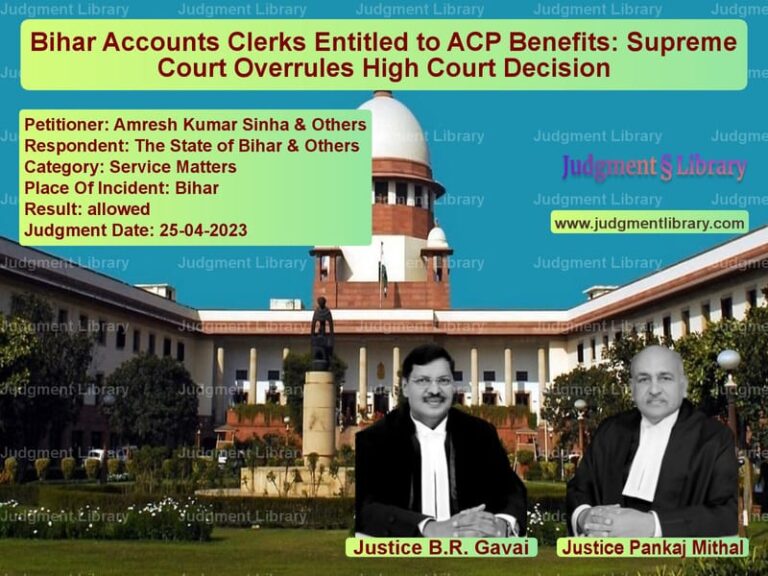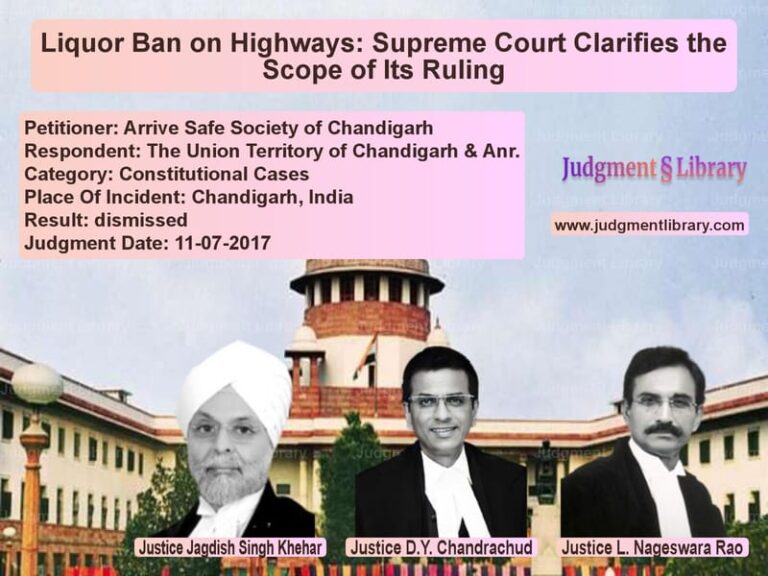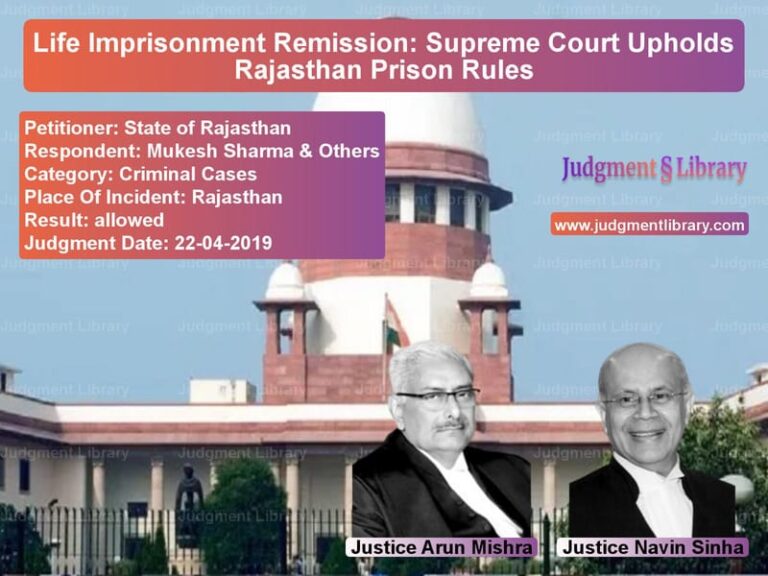Supreme Court Overturns Contributory Negligence Finding in Fatal Motor Accident Case
In a significant judgment that brings relief to families who lost their loved ones in a tragic road accident, the Supreme Court has overturned the finding of contributory negligence that had reduced compensation for the victims’ families by 50%. The case involved a fatal head-on collision between a motorcycle and an Alto car that claimed two young lives and left another person injured.
The tragic incident occurred on July 26, 2009, in the area of Police Station Kaithal. A newly purchased motorcycle was being driven by 22-year-old Gautam, with his 30-year-old brother-in-law Harpal Singh riding pillion. From the opposite direction came an Alto car driven by Gulzar Singh, with Kulwinder Singh sitting beside him. The two vehicles collided head-on, resulting in the immediate deaths of both motorcyclists and injuries to Kulwinder Singh. The car driver Gulzar Singh also died sometime later due to unrelated reasons.
The families of both deceased motorcyclists filed claims before the Motor Accident Claim Tribunal (MACT) in Katthal. Gautam’s parents, Rajo Devi and Prem Chand, sought compensation for the loss of their young son, while Harpal Singh’s widow and two minor children claimed compensation for their devastating loss.
The Legal Battle Over Fault and Compensation
The MACT, in its order dated June 3, 2011, made a crucial determination that would shape the case for years to come. The Tribunal concluded that this was “a clear-cut case of contributory negligence” and accordingly reduced the compensation payable to both families by 50%. The Tribunal assessed Gautam’s total compensation at Rs. 1,72,000 and awarded his parents Rs. 86,000 (50%). For Harpal Singh, the total compensation was assessed at Rs. 4,23,000, with his family receiving Rs. 2,23,000 (50%).
Dissatisfied with this outcome, the families appealed to the Punjab and Haryana High Court. The High Court, in its common order dated February 27, 2020, did enhance the compensation amounts significantly but maintained the finding of contributory negligence. The High Court increased Gautam’s compensation to Rs. 5,52,000 and Harpal Singh’s to Rs. 6,91,200, but both amounts remained subject to the 50% reduction due to contributory negligence.
The families then approached the Supreme Court, challenging both the finding of contributory negligence and certain aspects of the compensation calculation.
The Arguments Before the Supreme Court
The appellants’ counsel made several key arguments before the Supreme Court. He contended that “the impugned order is erroneous in not considering the testimony of other eyewitness namely, Suresh Kumar (PW4) and relying upon the testimony of Kulwinder Singh (PW 5) only.” This was a crucial point because PW4 had testified that “deceased Gautam was riding his motorcycle at a normal speed on his left side when the Alto car came from opposite side in a high speed and was very rashly and negligently driven.”
The appellants also challenged the differential treatment in assessing the incomes of the two victims. “The High Court erred in law by differentiating in the income of deceased Gautam and pillion rider Harpal,” they argued, noting that “the income of the deceased Gautam has been assessed at Rs. 4,000/- per month whereas that of deceased Harpal has been assessed at Rs. 5,000/- per month despite the fact that they both were in the same profession i.e. running a hair cutting salon and were hair dressers.”
Perhaps most importantly, the appellants brought forward new evidence – the site plan of the accident prepared by the investigating agency. They explained that “the site plan of the accident prepared by the investigating agency, which was not in the knowledge of the petitioners herein was never brought on record and that the same would show that the accident took place because of the negligence of the driver of Alto car only.”
The insurance companies, representing both vehicles, presented contrasting arguments. The counsel for Bajaj Allianz (insurer of the motorcycle) argued that “deceased Gautam, who was the driver of the motorcycle in question, was not holding a valid and effective driving licence” and that “as the motorcycle in question was not the offending vehicle, respondent no. 5 is not liable to pay any compensation.”
The New India Assurance Company (insurer of the Alto car) took a different stance, supporting the contributory negligence finding. Their counsel submitted that “the accident in question was a head-on collision and accordingly, the driver of both the vehicles need to be held responsible as they had contributed equally to the accident.” They also objected to the introduction of the site plan at this late stage.
The Supreme Court’s Analysis
The Supreme Court bench comprising Justices B.V. Nagarathna and Prasanna B. Varale began by addressing the procedural objection to the site plan. The Court took a compassionate view, noting that “the provision of providing compensation to the injured/dependants in accident cases under Motor Vehicles Act, 1988 is a beneficial provision to enhance social justice. Accordingly, the rigours of procedure cannot be allowed to defeat its purpose as the trial in such cases is summary in nature.” The Court therefore allowed the site plan to be taken on record.
The site plan proved to be crucial evidence. The Court’s detailed analysis revealed: “A careful perusal of the site plan shows that point ‘A’ is shown as the place where the accident took place and where the motorcycle was found lying. Point ‘A’ is on the left side of the road going from North to South. Point ‘B’ in the site plan denotes the place where Alto car was found lying. Point ‘B’ is on the extreme right side of the same road.”
The Court further noted: “The distance of point ‘B’ from point ‘A’ is about 62 feet, and of point ‘C’ about 18 feet.” This physical evidence was compelling – it showed that the motorcycle was on its correct side of the road when hit, while the Alto car had crossed over to the wrong side.
The Court connected this physical evidence with the eyewitness testimony that had been overlooked by the lower courts: “Therefore, as per the site plan, deceased Gautam was riding his motorcycle on his left side of the road when the Alto Car hit him. The site plan also corroborates the testimony of eyewitness PW4, complainant Suresh.”
Based on this comprehensive analysis of both the documentary evidence (site plan) and testimonial evidence (PW4’s statement), the Court reached a definitive conclusion: “Thus, in view of the above discussion, this Court finds that the accident in question took place due to rash and negligent driving of Gulzar Singh only, driver of Alto car and there was no contributory negligence on the part of deceased Gautam.”
The Final Compensation Award
Having established that there was no contributory negligence on the part of the motorcycle rider, the Supreme Court proceeded to award full compensation to both families. The Court noted: “In view of the above discussion this Court is of the view that the High Court has erred in upholding the application of the principle of contributory negligence and thereby deducting the amount of compensation entitled to the deceased persons by 50%. Therefore, this court is inclined to enhance the amount of compensation by amount which was deducted by the High Court on account of contributory negligence.”
The Court calculated the final compensation amounts as follows: “Thus, the total amount of compensation to which deceased Gautam is entitled to is Rs. 9,84,000/- [Rs. 5,52,000 (compensation calculated by the High Court) + Rs. 4,32,000/- (Compensation deducted by High Court on account of contributory negligence)]. Furthermore, the total amount of compensation to which deceased Harpal is entitled to is Rs. 12,62,400/- [Rs. 6,91,200/- (compensation calculated by the High Court) + Rs. 5,71,200/- (Compensation deducted by High Court on account of contributory negligence)].”
The Court maintained the interest rate of 9% per annum as awarded by the High Court and directed that “The balance amounts to be deposited with the MACT with interest within a period of six weeks from today.”
Broader Implications of the Judgment
This Supreme Court judgment carries significant implications for motor accident claims in India. First, it reinforces the principle that the Motor Vehicles Act is a beneficial legislation meant to provide social justice to victims of road accidents. The Court’s willingness to accept the site plan at the appellate stage demonstrates a compassionate approach that prioritizes substantive justice over procedural technicalities.
Second, the judgment provides important guidance on how contributory negligence should be determined in road accident cases. The Court emphasized the importance of considering all available evidence, including physical evidence from site plans and testimony from all eyewitnesses, not just selective evidence that supports a predetermined conclusion.
Third, the case highlights the crucial difference between a mere head-on collision and one where contributory negligence exists. The fact that two vehicles collide head-on does not automatically mean both drivers were equally at fault. The actual positioning of the vehicles, as evidenced by the site plan, and the testimony of reliable witnesses must be carefully evaluated to determine who was actually at fault.
The judgment also serves as a reminder to lower courts and tribunals to be thorough in their examination of evidence in motor accident cases. The failure of both the MACT and the High Court to properly consider PW4’s testimony and to obtain the site plan nearly resulted in a grave injustice to the victims’ families.
For the families of Gautam and Harpal Singh, this judgment brings closure to a legal battle that lasted nearly 16 years. While no amount of money can truly compensate for the loss of a loved one, the full compensation awarded will at least provide some financial security to the aged parents who lost their young son and the widow and children who lost their husband and father.
The case stands as a testament to the Supreme Court’s role as the ultimate guardian of justice, ensuring that technicalities do not defeat the substantive rights of accident victims and their families.
Petitioner Name: Rajo Devi & Anr. etc..Respondent Name: Manjeet Kaur & Ors..Judgment By: Justice B.V. Nagarathna, Justice Prasanna B. Varale.Place Of Incident: Kaithal, Haryana.Judgment Date: 19-05-2025.Result: allowed.
Don’t miss out on the full details! Download the complete judgment in PDF format below and gain valuable insights instantly!
Download Judgment: rajo-devi-&-anr.-etc-vs-manjeet-kaur-&-ors.-supreme-court-of-india-judgment-dated-19-05-2025.pdf
Directly Download Judgment: Directly download this Judgment
See all petitions in Road Accident Cases
See all petitions in Compensation Disputes
See all petitions in Motor Vehicle Act
See all petitions in Negligence Claims
See all petitions in Insurance Settlements
See all petitions in Judgment by B.V. Nagarathna
See all petitions in Judgment by Prasanna Bhalachandra Varale
See all petitions in allowed
See all petitions in Modified
See all petitions in supreme court of India judgments May 2025
See all petitions in 2025 judgments
See all posts in Accident Cases Category
See all allowed petitions in Accident Cases Category
See all Dismissed petitions in Accident Cases Category
See all partially allowed petitions in Accident Cases Category

